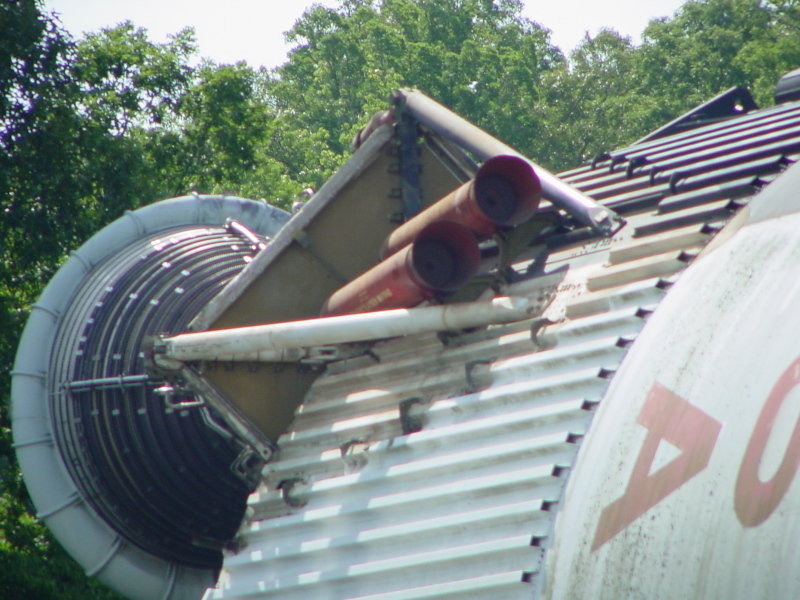| Prev |
heroicrelics.org USSRC Saturn V Restoration Site Index Saturn V Restoration (June 2005) Gallery |
Next |
dsc09764.jpg
Detail of the S-IC retro motors. There were two of these motors under each fairing. After the S-IC depleted its propellant and was staged, these retros would fire, burn through the top part of the fairing, and decelerate the stage to aid in separating it from the rest of the Saturn V. As a weight-saving measure, four retros were removed S-IC-10 (Apollo 15); however, this did not provide sufficient clearance margins and the four retros were restored for the remaining flights.
On a flight stage, these would be "TE-M-424 solid-propellant retro motors." As this particular S-IC is S-IC-D, the dynamic test stage (installed in the Dynamic Test Stand at Marshall Space Flight Center and shaken, rattled, and rolled to simulate vibration during an actual flight), rather than being an actual retro motor each one is instead a "Mass Simulated Motor - Non-Explosive".
The numbers printed on the body appear to read "60847058-1", "E0 2", and "E0 1".
Some time ago, I exchanged emails with a retired Thiokol engineer who worked on the S-IC retros. When I showed him these pictures, he had the following comments:
The dummy retros shown may be a bit misleading with those prominent exit cones. The Saturn retros were designed with submerged nozzles and external extensions, like many upper-stage motors. This was for a variety of reasons - ballistic performance mostly - as well as limiting the overall length of the rocket motor assembly. Static tests performed at sea level and, more importantly, at altitude, demonstrated more than acceptable performance without the nozzle extension. As I recall, most of the motors we tested in the qualification program had the extensions removed, but whether delivery motors were so modified, I don't know! The external cones were un-insulated steel assemblies, threaded to mate with the internal portion of the nozzle and were easy to remove. The photos in the AEDC report show the nozzle extensions in place and the data from those simulated altitude tests probably demonstrated that the nozzle expansion ratio provided better performance than needed, hence the subsequent removal of the extensions. This is all from memory, and an educated guess on my part. I was concerned with performing tests and acquiring accurate data - the conclusions drawn from the data were a matter for the rocket engineers. Flight motors may very well have had the extensions installed, despite what I recall!
While the copy of the report to which he refers showing the retros installed inside the fairing, the giant 1:10 scale Saturn V models, and early diagrams of the S-IC all show fairings on the retros, I don't believe I've ever seen any photos of flight stages with them installed.
Picture 2 of 2.
Although the focus in this picture is not the best, it clearly shows that the throat of these mass simulators are closed.

| Time picture taken | Fri Jun 17 09:48:52 2005 |
| Location picture taken | Rocket Park US Space & Rocket Center Huntsville, AL |
| Prev | Saturn V Restoration (June 2005) Gallery | Next |